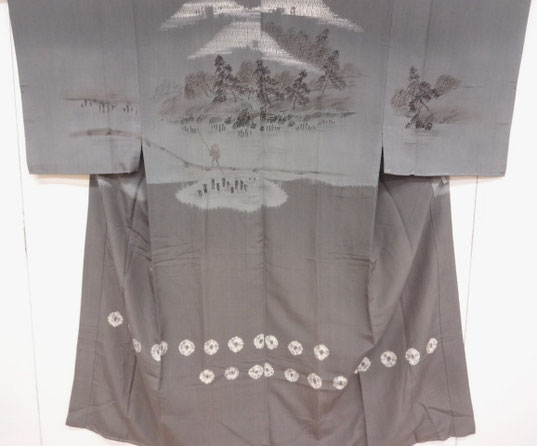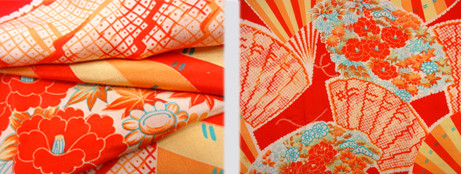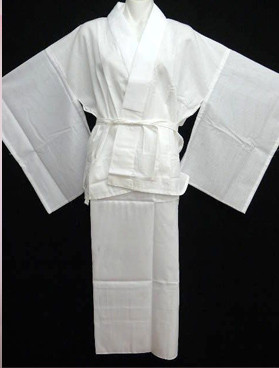Kimono Mochi
••••
Juban
••••
Juban covers a wide range of undergarments which are worn between the silk kimono and the skin, to protect the delicate, expensive and often unwashable kimono from sweat and skin oils. Juban worn next to the skin are generally described as hadagi or hadajuban and need to be washable, so are cotton, hemp, linen or, more recently, synthetic fibers. Nagajuban are the outer layer of kimono underwear, and can be silk or synthetic, lined (awase) or unlined (hitoe). In summer, one can lessen the layers or just wear a han-juban (literally half-juban) with no susoyoke (skirt). The only part of a juban which is seen after dressing is the collar, which is removable so that a clean matching collar can be replaced at short notice. collars (eri) are a separate area, with many types, fabrics and levels of intracacy.

Men's hiraginu silk juban
I've pulled this men's juban out of my collection as it's typical of its type (this is actually a nagajuban, the garment worn between
the washable hadagi base layer in contact with the skin, and the silk kimono itself, which cannot be easily washed and so needs protection from skin oils and sweat). It has a little shibori work,
a technique which often appears on outer kimono and features on several of my furisode, but is also often seen in good quality juban. This time the shibori is visible in two places, utilizing two
techniques; the first and most noticeable are the large spots to the lower body used as an accent rather than the main design, which is a hand-painted scene of mountains and a stream, over varied
resist-dye and over-dyed areas. Within that, there's further shibori work in the mountains themselves, which utilize itajime shibori to hold out the background dye and create snow-capped
mountains.
Unlike women's kimono, men's kimono ensemble tend to be very plain and austere in colour and design, with very little variance. Individuality is expressed in the unseen juban, and in the lining of the haori worn over the kimono, of which small flashes can occasionally be spied. There are many collectors who buy haori expressly for their lining, and indeed they're often sold through pictures which show them inside-out, to display these barely-glimpsed works of art. Sourced in Nigata province, Japan.

Men's silk juban
I thought I'd pull another one of my favorites out of the closet. This is a lined (awase) early Showa-era men's juban in a wonderful
all-over pheonix design of mustards and moss greens on a black ground. The kinsha silk is very fine quality, and this entire piece simply oozes confident refinement.
I like this piece because you can clearly see the link between its design pattern and British Liberty patterns which stemmed from the Arts and Crafts movement, itself a group which took inspiration from many facets of Japanese design and craftsmanship in the late 18- and early 1900's . The fabric really wouldn't look out of place in any Liberty window, then or today. In return, the Arts and Crafts movement inspired Yanagi Sóetsu to create the Mingei movement in Japan in the 1920's, itself espousing the importance of traditional hand-made crafts in an increasingly industrialized society. In this one piece, never even designed to be seen save by the wearer, we can see Japan taking its place in the larger international society, both inspiring and inspired by global themes. Sourced in Kyoto, Japan.

Antique woman's silk furisode juban
Length: 52.5"
As can be seen from the sleeve drop, this juban is intended for use under a furisode. In fact it's useful to be able to see the true length of furisode sleeves by looking at how closely this juban's sleeves come to the bottom of the garment, a fact that is far harder to judge when viewing furisode open and flat, because in this form their length also accounts for the ohasori (a fold made to the length of the kimono at the waist, visible under the obi when dressed, and generally accounting for around 7 to 10"). Juban are worn an inch or so shorter than the outer kimono to ensure that they're never seen below the hemline, but it's clear that this sleeve would come to the required ankle-length on its wearer.

This particular juban is awase (lined), and is probably an early to mid Showa juban, since strong patterns and bright colours were largely out of favour by the 1950's, being replaced by the pastel pinks and whites which still dominate today. Sourced in Osaka, Japan.

Antique ro men's juban with hand-painted lobsters
This is an antique ro men's summer juban (ro juban are always unlined) with a combination of several holdout and overpainted
techniques. Each of the lobsters is slightly different, as are the hand painted representations of water.
Ro was the juban of choice in the hot summer weather of July and August, where the loose weave spaced by removal of several weft
threads to form a pattern was considered cooling, as is the suggestion of water, with the subject matter of this juban.

Again here, we can see a little personal expression coming into one of the few garments through which a man was capable of expressing it, though this time in a far more subdued yet oddly playful manner. Here's a close-up of one of the painted lobster, in which you can see the open-weave texture of the ro fabric.
Sourced in Osaka, Japan.
Don't forget you can navigate between pages by clicking on the small blue three-bar icon at the very top left of this page - other pages and subjects will appear.


Women's rinzu silk juban with yuzen
Here's an awase (lined) winter women's chirimen silk nagajuban from the Taisho era. Discounting fabric, the most notable identifier between women's and men's juban are the sleeves. Length changes not just to match the outer garment, but also according to the time period. This Taisho juban for instance has longer sleeves to match the fashionably longer-sleeved kimono of the period; later sleeves would shorten, and so of course juban did the same. But a woman's kimono or juban can also be identified because the sleeve seam nearest to the body, and the first several inches of the body itself down towards the waist, are always tailored to be open. On a man's kimono the sleeves are sewn into the body, with no opening. The break in women's kimono reflects a need to allow for the wide obi worn by women, in comparison to men and children; without it, the kimono would bunch unattractively across the arms and body, down to the waist. Cutting the sleeves free of the body allows the obi to pass between the body and the sleeves without pulling at either to do so. In a subtle pointer to a woman's place in past Japanese society, younger boy's kimono would have openings similar to a girl or woman's kimono; all three groups were considered to have a status below men. A second indicator is the outside lower edge of an outer kimono sleeve; the younger the wearer, the more pronounced the curve. As sleeves were shortened after marriage, this outer curve was tailored squarer, to indicate a less frivolous wearer who had taken her adult place in society. Though sometimes this aesthetic was more pronounced than others, you can see indications of it throughout the kimono on this site, where unmarried women's furisode sleeves curve to the outside lower edge of the hanging sleeve, whilst short-sleeved kimono and juban for married women have a definite squareness to them--though not as much so as a man's boxy kimono sleeve. Sourced in Osaka, Japan.

Women's bokashi silk juban with yuzen
This is a vintage awase juban with a beautiful bokashi (dip-dye) background on a rinzu (figured) silk. Held out from the bokashi are a series of hand-painted yuzen clusters of vine leaves, grapes and stylised clouds.
This is another piece which, like the red Meiji furisode, is very hard to photograph as it has a luminescence which seems to throw light back to the camera.
In this instance however, all of the dyes seem man-made, though the colours are quite subtle compared to the bright, acidic colours
of the furisode juban higher up the page, still visibly trying to mimic natural dyes.

Here's a
closer shot, in which you can see the colourwash detail of the painted leaves, as well as the clean holdout areas. The background rinzu of leaves and flowers is also
far clearer on close-up. Again, this could very easily have originally been either a Taisho-length sleeve or a full furisode sleeve, and been re-tailored as styles and necessity demanded. Most
modern juban are rarely bright, unless they're made specifically for furisode, though you can still see the tradition of strongly coloured juban persisting in the geisha community, where both
geisha and maiko take great pride in showing off daring glimpses of bright red juban to great effect!
Sourced in Osaka, Japan.

Women's full yuzen kinsha juban
Another vintage awase juban, this one more ornate, with an all-over yuzen design on kinsha silk, and some hira-nui embroidery and
kinkoma (gold thread couching) over a figured silk base. The red lining of this juban shows through a little onto the white outer shell, giving it a very slightly pink appearance, but there's no
actual transfer of colour.
It's an interesting mix which I don't think you'd ordinarily see in the West, of a very strong red-orange, with detailing within the
ouigi in a

true almost peachy orange, which I've shown in close-ups.
You can also see the gold couching, as well as a little of the embroidery to one of the blossom's stamen. And again in this
older juban, as with the one above, you can see that the man-made synthetic dyes are still trying to mimic more natural colours, rather than the harsher colours of the furisode juban higher up
the page.
Again, sourced from the same supplier as the one above, in Osaka, Japan.

Women's hiraginu silk awase juban
The silk of this juban is hiraginu, which is a smooth lightweight silk more often seen in men's kimono and juban. The lining is a lightweight, closely-woven cotton. Cotton linings weren't unknown in silk kimono, but it's more likely that this one has had its lining replaced at one point, since the weight of the lining seems a little heavy for the weight of the outer silk. The juban is of interest in that it spans the time period post-Taisho--as those immediately above are--but before the Showa furisode juban, when man-made synthetic dyes were beginning to change the type of colours used--in essence, it marks the move from dye strictly trying to reproduce a natural colour palette, to redefining its own palette of far stronger hues.

Despite this change to a more confidently man-made palette, the sho-chiku-bai design of this juban (sho-chiku-bai is a Chinese reading of 'matsu':pine , 'take':bamboo and 'ume':plum) is very traditional, and the sleeve length is correct for the age of the piece. From here, juban colours began to soften and silk became more and more lightweight, with juban styles narrowing to just a few colours and material types with few variations, save to fit the style of kimono they were to be worn with. Sourced in Kobe, Japan.

Women's synthetic juban with shibori
By comparison, here's a contemporary women's juban, very typical of its type (although this one has chu-furisode sleeves, as opposed to the standard 48cm). Anyone who wears kimono will have a huge stash of these, in an assortment of pastel pinks and whites, as well as sleeve-types (the sleeve length and drop of the juban must match the sleeve length of the outer kimono--the same is true of body width, otherwise the two items will not hang correctly together). These days, there are also types with handy detachable sleeves, which can then be matched to the outer kimono. Though often still hand-sewn, these juban tend to be hitoe (unlined), to make them easy to wash by hand. Underneath this, one would still wear a cotton hadagi, though the washability of polyester means it's not strictly speaking necessary if the weather is a little warm.

Here's a generic picture of the typical nagajuban, which can be produced in varying grades of cotton from gauze to thermal, which wearers also have multiples of. This one is a two-piece, which are considered more versatile, since the top (han-juban) generally needs more washes than the skirt, and in summer the susoyoke (skirt) is often omitted to keep cool (myself I don't like the two-piece nagajuban, as either they're folded uncomfortably thickly at the waist, or the bottom of the han-juban leaves the kimono equivalent of a vpl! I also find it harder to make the outer eri sit straight without the weight of a full-length nagajuban).
Different dressing schools also recommend the use of different types of hadajuban and nagajuban, some with collars attached separately, some with imonnuki, some with han-juban...everyone has their favorite!
When wearing yukata, only a simple cotton hadajuban of the type shown below is worn, which has partial or no sleeves, and more
importantly no collar. For coolness, no further juban is used.

Occasionally these days one can also see a high-end yukata dressed up with a collared cotton juban whose eri is linen, cotton or ro,
for a casual evening meal out. But in general the most reliable way to tell a hadajuban or a yukata juban from a nagajuban (and therefore which order to dress in!) is that the former two will
have no collar. When wearing juban, new collars (eri) are needed in ever-renewing quantities, as they soil quickly, and it's generally easier to simply swap them out after a few washes than it is
to try to get them clean, especially if the eri is silk.
Just to complicate things further, a collar-guard or imonnuki is a narrow strip of fabric often used either separately (pinned on) or sewn into the juban at the collar and then pulled downward to tie at the waist in order to keep the juban--and so the kimono--collar perfectly aligned. Awry collars and ohasori are the bane of many a kimono-wearer's life!
